In our quest to build our dream farm, we started with a crazy, mid-pandemic move out of suburbia and onto a 10 acre rental property. We made the move in order to gain the time and resources to hunt for our forever farm and try out aspects of our desired lifestyle. What, specifically, would we do with our year of rural renting? It was the wrong time of year to start a vegetable garden, large animals take time to find and are hard to move, and bringing the soil ecosystem into good health would take years.
To start something immediately, we settled on raising enough meat chickens for our family for a year, about 100 birds. For us, those 100 meat chicks were a step towards more sustainable food, an experiment with pasture raising birds, and a chance to learn more about what we need to create the curated ecosystem that will support our food animals.
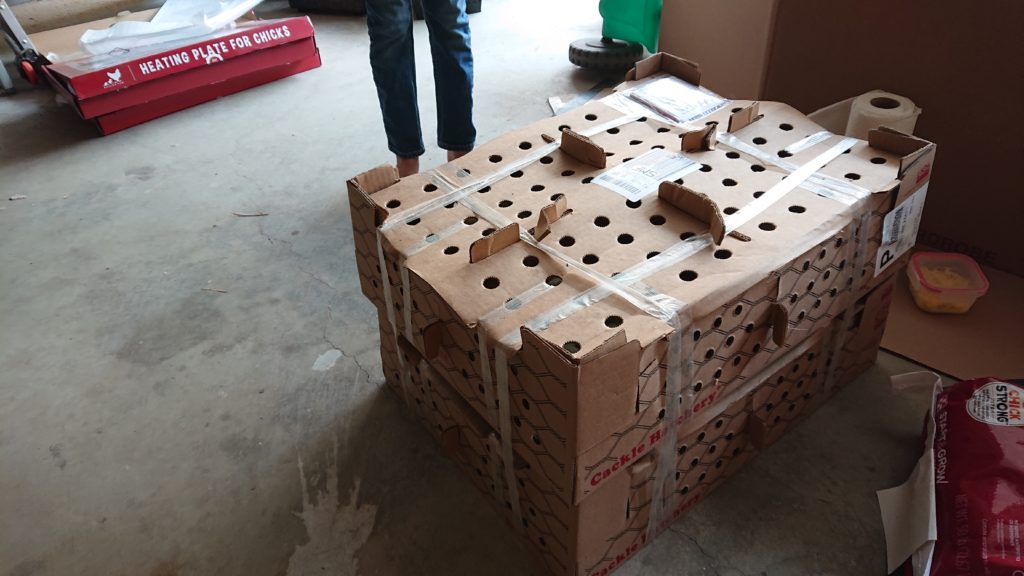
What 100 day old chicks looks like going through the USPS. USPS remains the most economical way to ship livestock because they are a government organization.
Conventional meat birds are unsustainable to produce, both ecologically and societally. Chickens that come from the average supermarket are produced by one of four companies: Pilgrim’s Pride, Tyson Foods, Perdue Farms, and Sanderson Farms (Farm Action Alliance Concentration Report). These companies own the birds from beginning to end, and contract small farmers to raise them according to company specified practices. Predatory lending allows the companies to offload the capital expenses onto the farmers and lock them into contracts. Birds are kept by the thousands in enormous barns, fed company prescribed food, and generate toxic amounts of chicken waste that is bad for the birds, the farmers, and the surrounding area. The quadropoly presents a systemic societal and ecological problem, but there are more equitable ways to raise birds without the environmental mess.

Our mini-worker putting together the long sides of a chicken tractor.
Pasture raised meat has become an increasingly popular option for the culinary ethicist. Animals raised on pasture are portrayed as happy, healthy creatures who prance around enormous fields, munching blissfully on grass, with nary a care in the world until they meet their end in some uncontemplated humane fashion. Assuming the meat is not being provided by a huge company that is using deceptive advertising practices to make customers believe in this painted pastoral, the idea is not too far off from possible. The problem with it is cost. Getting meat from a place that actually raises animals in a manner that is good for both the animals and the environment takes more time, more effort, and usually more space. Thus, the resulting meat is much more expensive (Costco rotisserie chicken, $5*, Primal Pastures whole bird, $31.99 as of this writing). We had the space, time, and resources to obtain and raise the chicks ourselves, so pasture raising them was the obvious best choice.
*Update: Costco has been taking a beating over their chickens in the news media lately. This is both understandable and wrong. Costco is overall a really ethical company, which is why it’s so easy to get mad at them when they participate in systems that are so flagrantly unethical. Keep supporting Costco, they still treat their employees better than other places, they still are good about pushing back on growing wealth division, and they still are making good brands mainstream. If you want to personally push back on the evils of standard chicken meat production, don’t buy chicken unless it has been pasture-raised, preferably directly from the farmer. If you are looking for ways to fix the system, we are working to provide links to both educational resources and organizations that are working to push for positive systemic change.
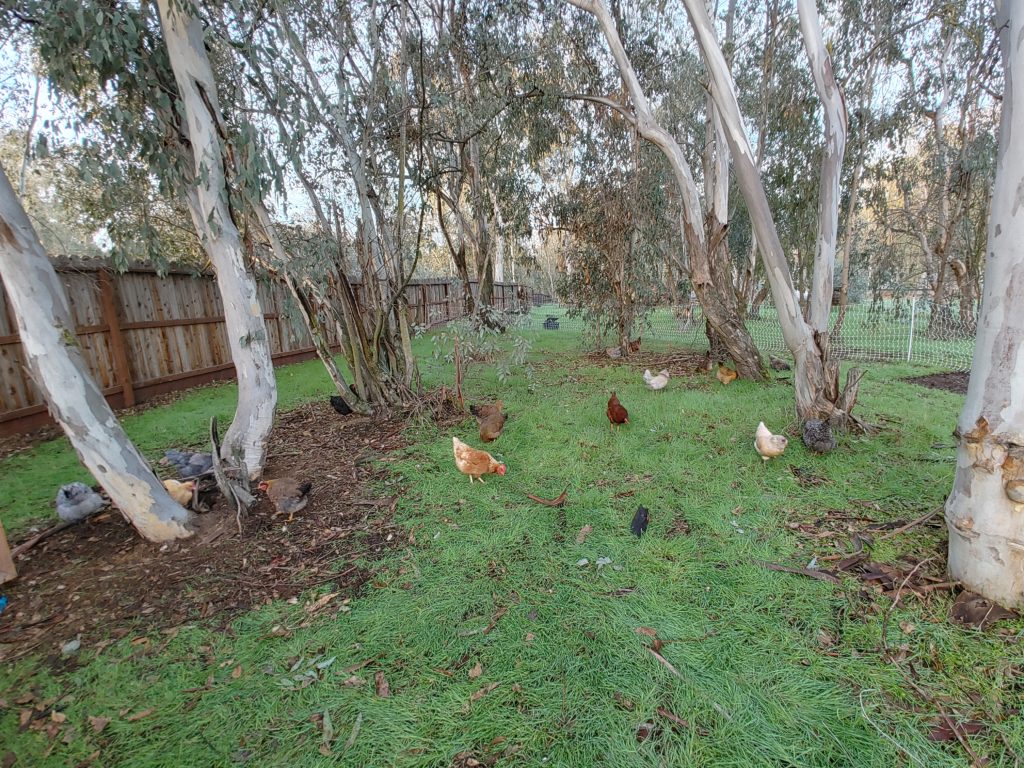
Painted Pastoral:
Our laying hens on the shaded part of the pasture after it started raining. They are pretty happy.
While studying small scale, ecologically friendly farming techniques, we stumbled across a few methods for raising chickens on pasture. When our chicks arrived, we chose Suscovich tractors to protect our birds on the pasture when they grew big enough. It takes three to four weeks before chicks are capable of maintaining their temperatures well enough to be put outside. Our fuzzy piranhas were cute, stupid, voracious eaters, and impossible to keep clean. For three weeks, they lived in a huge cardboard brooder in our garage with heat plates, bedding, food, and water, and the first noticeable benefit to having them in a tractor on pasture was that they could be moved off of yesterday’s excrement.
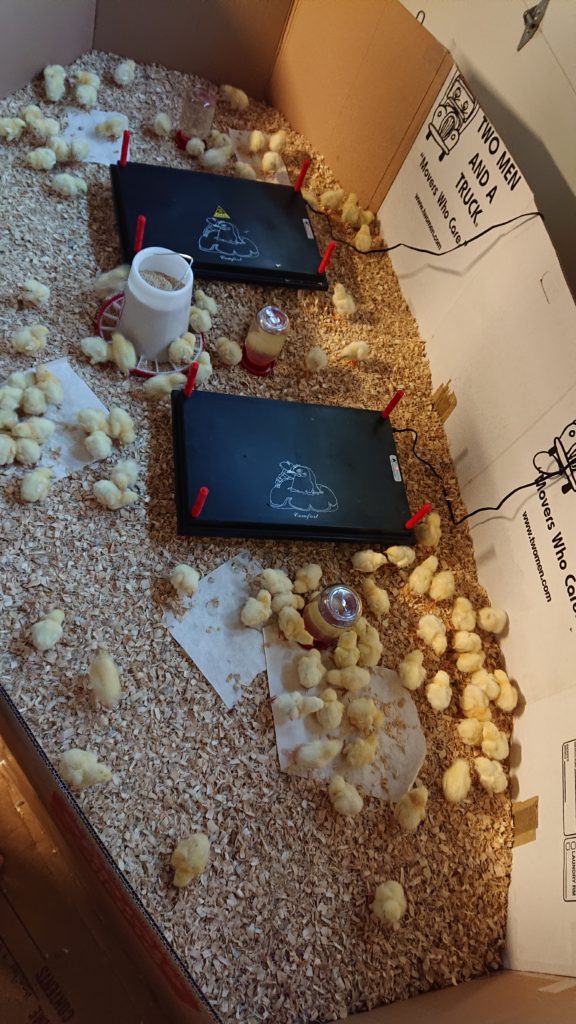
Our garage brooder box the day after the chicks came. These large heat plates resulted in chicks trapping each other in the center and overheating. We’ll use more smaller ones next time. 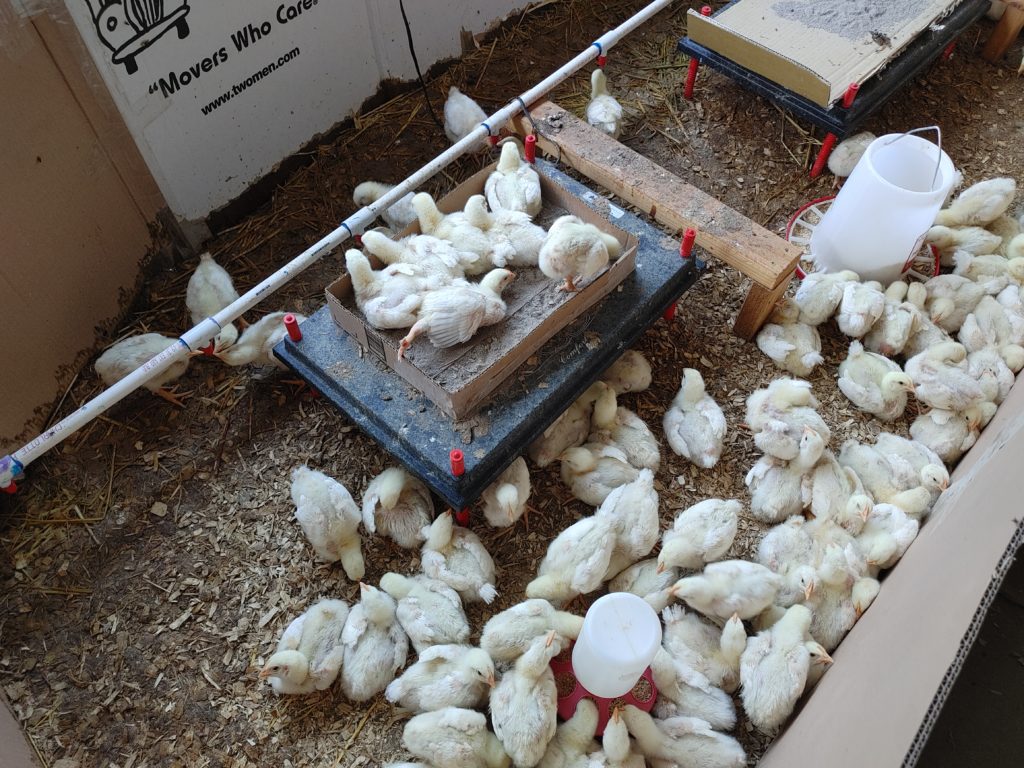
Towards the end of their time in the brooder. Even in an enormous brooder, 100 chicks manage to be all over everything all the time. 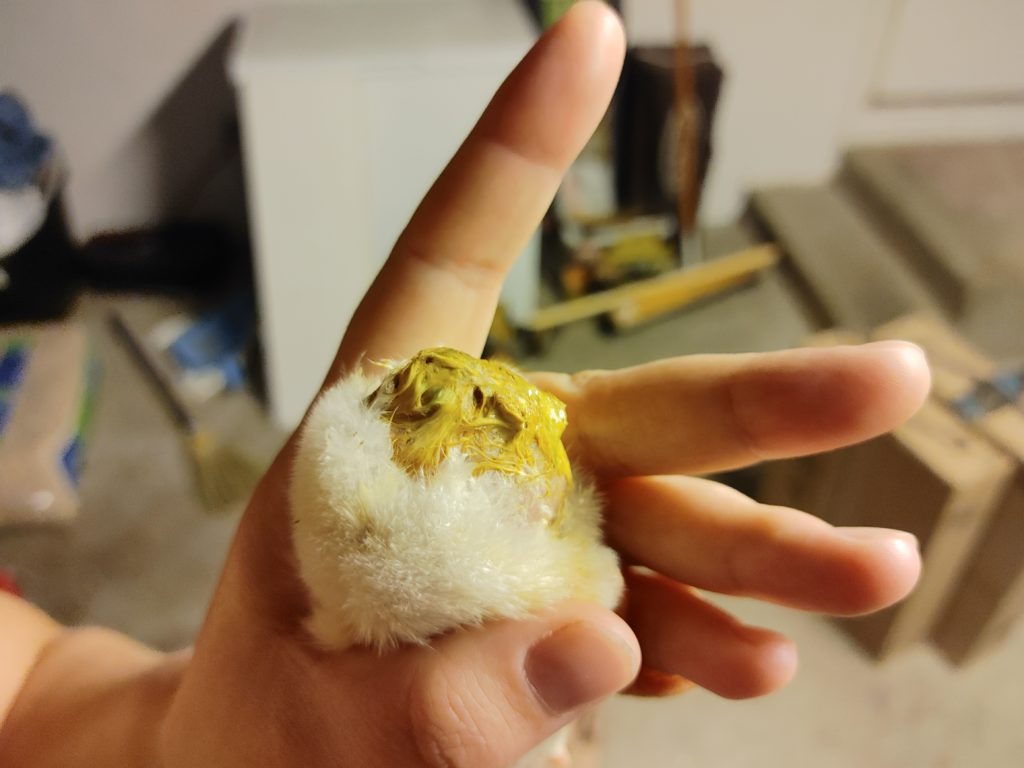
Our only case of pasty-butt made up for it by being epic.
Once in the tractors, we could start to see how chickens impact pasture. Our pasture started as hard clay dirt covered with soft dead grasses. The birds did a good job of digging up the dirt and evenly distributing poop around it, but two weeks into having the chicks on pasture we were slightly disappointed that their poop wasn’t noticeably broken down. We hypothesized that the soil was too dry and lacked sufficient microorganisms to work through the poop quickly. We started following the tractors with a sprinkler and pasture seed, but then it also started raining. The grass is growing but it is impossible to tell if the new grasses are due to our treatment of the pasture or just a seasonal occurrence. This was our first but probably not our last practical lesson in the difference between the science of farming vs. the art of running a farm. We have BA’s in biology and physics, but it is as impossible for us to run controlled experiments within our farming context. We are caring for an ecosystem with variable responses and our goal isn’t to understand it completely. Our goal is to create a healthy, functional, productive system. The pasture looks healthier now, and that is what is immediately important.
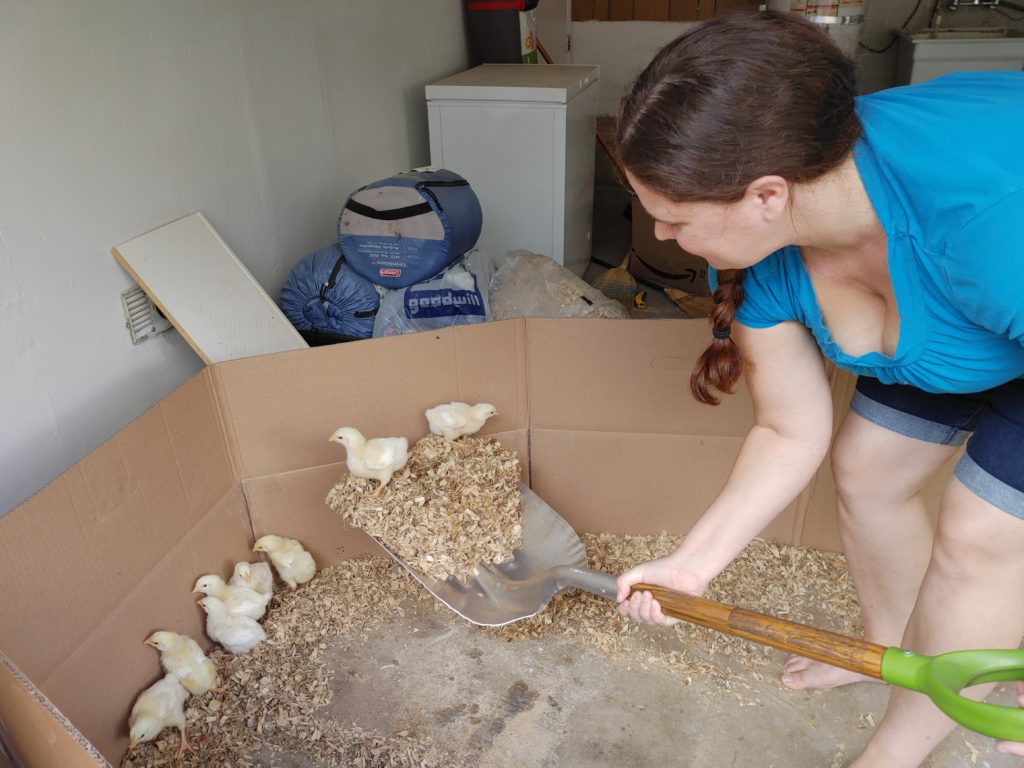
We had to scoop out all the bedding at least every few days. They were afraid of the concrete floor. 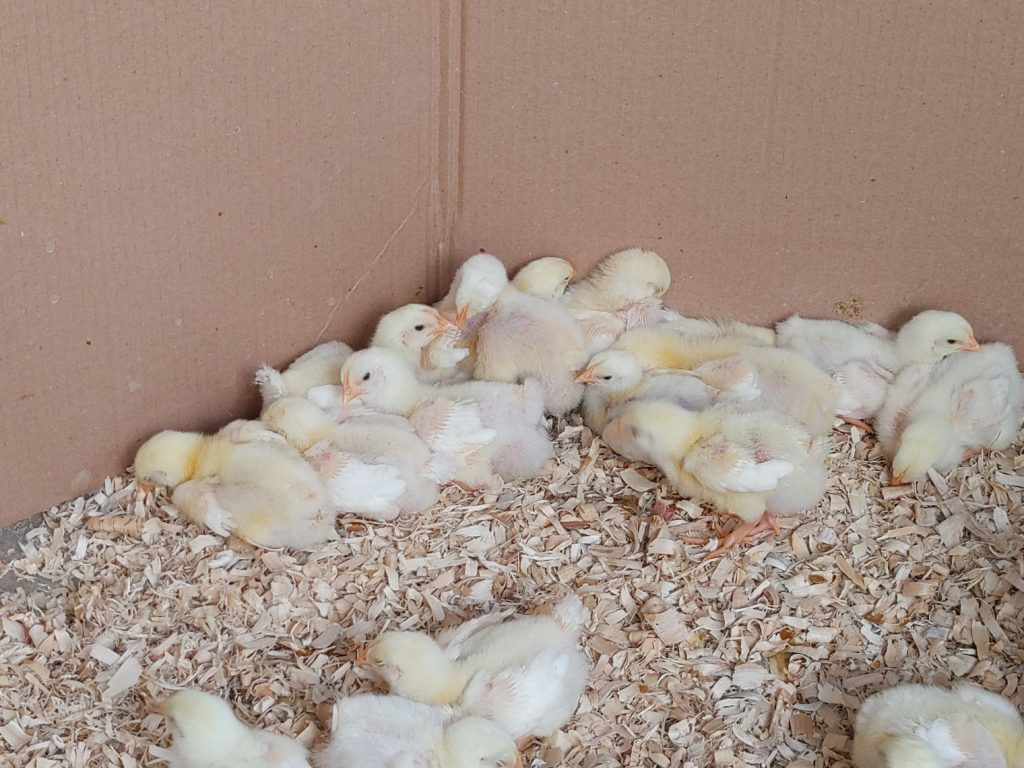
The chicks were much lazier than other chicks we’d raised. They spent a lot of time cuddled together resting. 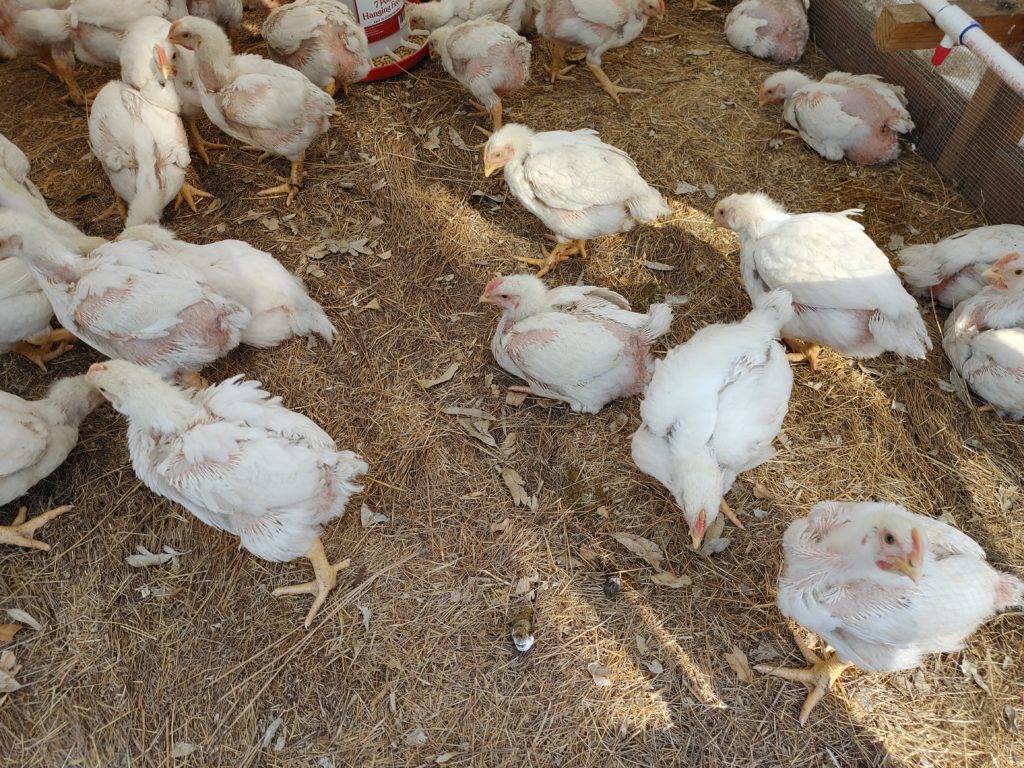
Our birds, shortly after moving into a tractor. They could scratch and dust bath more easily, but they are literally growing too fast for their feathers to keep up.
We learned a lot from our experiment with pasture-raised meat birds: they are relatively easy to raise, they did not hurt and may have helped the pasture we raised them on, and they were relatively healthy and happy until the day they met their end. We fed, watered, and moved their tractors daily. Sometimes they refused to move with the tractors and we had some injuries as a result, but we wound up with about 99 in the freezer. Butchering took substantially longer than we budgeted, but that was primarily due to our lack of a good butchering space and skill. The main improvements to our system would be in having a portable food storage structure to follow the tractors, and a better butchering set-up for the end.
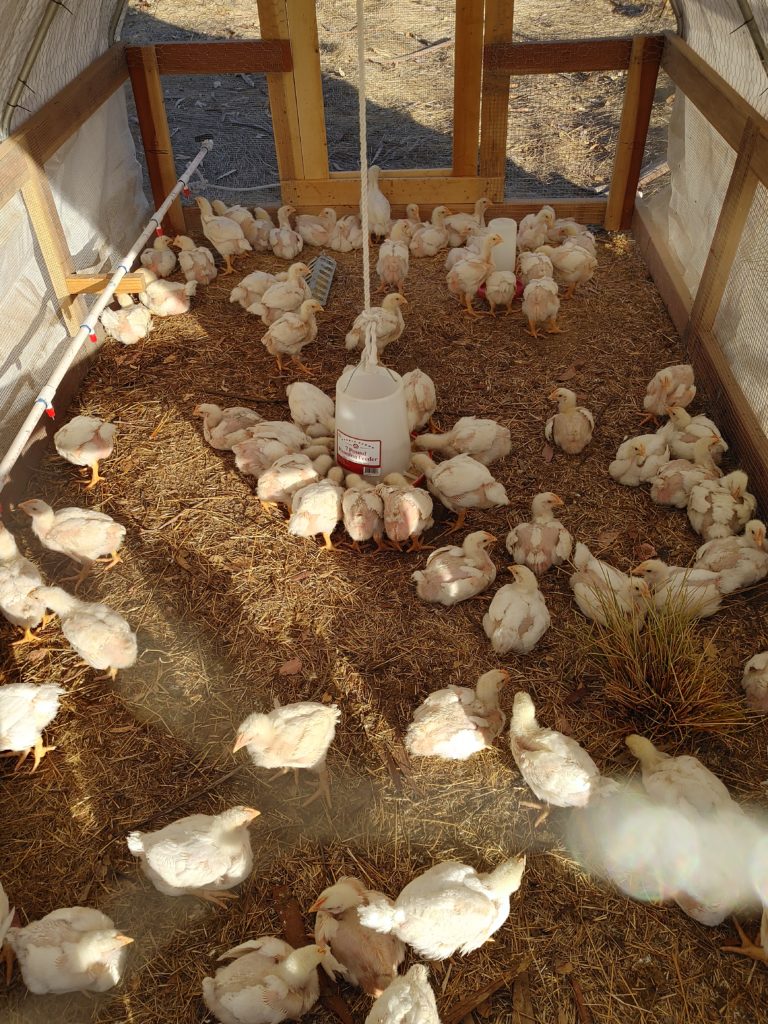
Early in their time on pasture, about 4 weeks. 
Our birds at the end of their time on pasture. 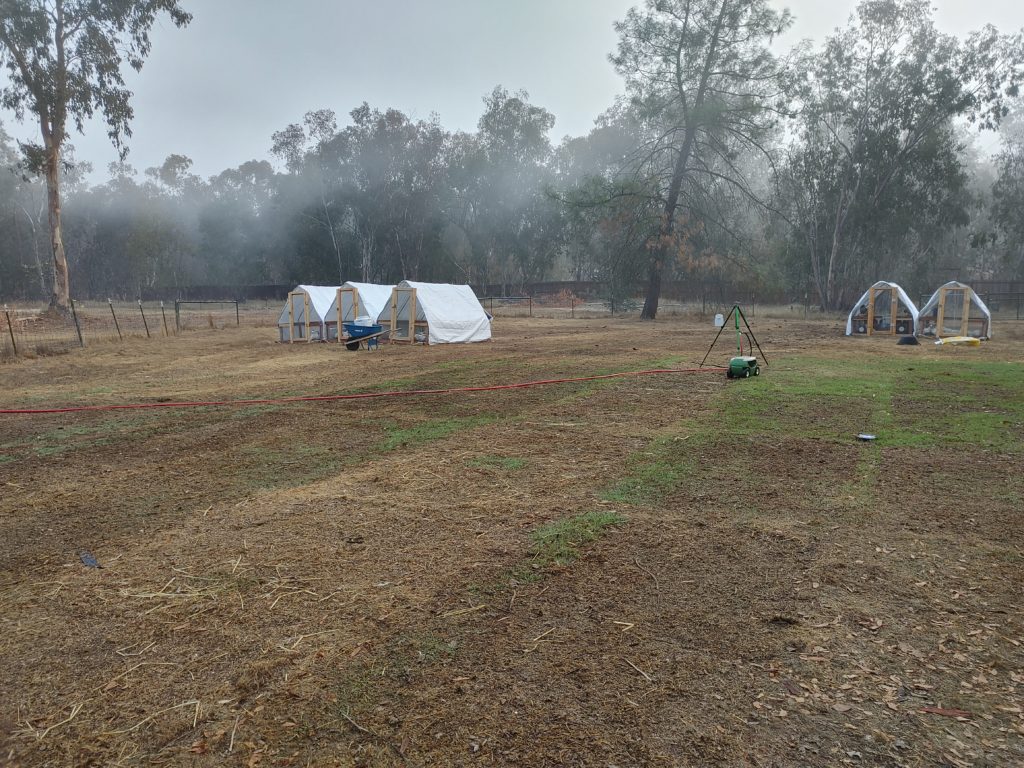
Towards the end of our informal chicken experiment, the tractors had been on most of the pasture and left their mark. The greener rectangles are in general the least recently scratched.
The cost of the chicks plus the feed to get them to eight weeks came to about $10 per bird, and that ignores both capital expenses and labor but will undoubtedly use our infrastructure to raise meat birds again in the future. Meat animals are a good, relatively easy way to make a farm some cash. Despite it being environmentally cleaner and more equitable to the farmer, selling pastured meat directly to customers is inequitable: buying and eating pastured poultry is a status symbol and this type of food is inaccessible to the vast majority of people in our society who lack the cash to buy or connections to barter it. The problem is systemic: fixing the system requires us to work as a group to examine, evaluate, and replace what is broken. Decreasing income inequality would help, breaking up the quadropoly that controls the poultry industry would help, re-examining agricultural policy to help farmers not big corporations and providing both public and private support and science-based regulations and resources for small species-diverse farms would help. We do what we can to understand the big picture, individually support healthy practices as much as possible, and vote for people and legislation that will encourage and support those healthy practices more broadly. Individuals can and should take individual actions, but ultimately, we need to act together.

The view from our window at sunrise.
Next week, we’ll post Part II with a description of butchering and what it is like to eat birds that you raised and butchered yourself.
Bibliography:
Family Farm Action Alliance
USDA Broiler Chicken Industry Data
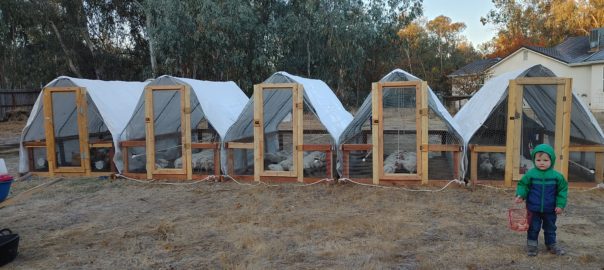
I look forward to the next installment, thank you!
I so appreciate your clear explanations of what you have been doing and why. I admire your family’s work ethic. Thank you for including us on your journey.
Very informative.thanks.
Very good, and timely considering the New York Times article.
Ok how we remember…..
Interesting to read what you are doing and remembering when Dan, Ben and Cindy would come out to Cattleana Ranch. I give you credit for raising and butchering chickens. After years of raising chickens, we didn’t butcher them, the smell of 1,000 chickens effected me to the point I still eat very little chicken. We have sold most of the farm and retired to Tucson AZ. We have found grassfed local beef via the University of Arizona meat processing program and meat store.
Good luck
Susan
Susan, thank you so much reading, it’s so good to hear from you! I remember Cattelana fondly. I didn’t ever think I’d go down a road like this back then but looking back with 20/20 hindsight you were definitely an inspiration. It was good to process the 100 chickens ourselves but we probably won’t be doing that number again anytime soon and will be taking them to a local butcher instead. I’d love to pick Tom and your brains about the financial forecasting side of running a farm some time. Also, we’ll hopefully be getting our first cow in a couple of months.
~Daniel